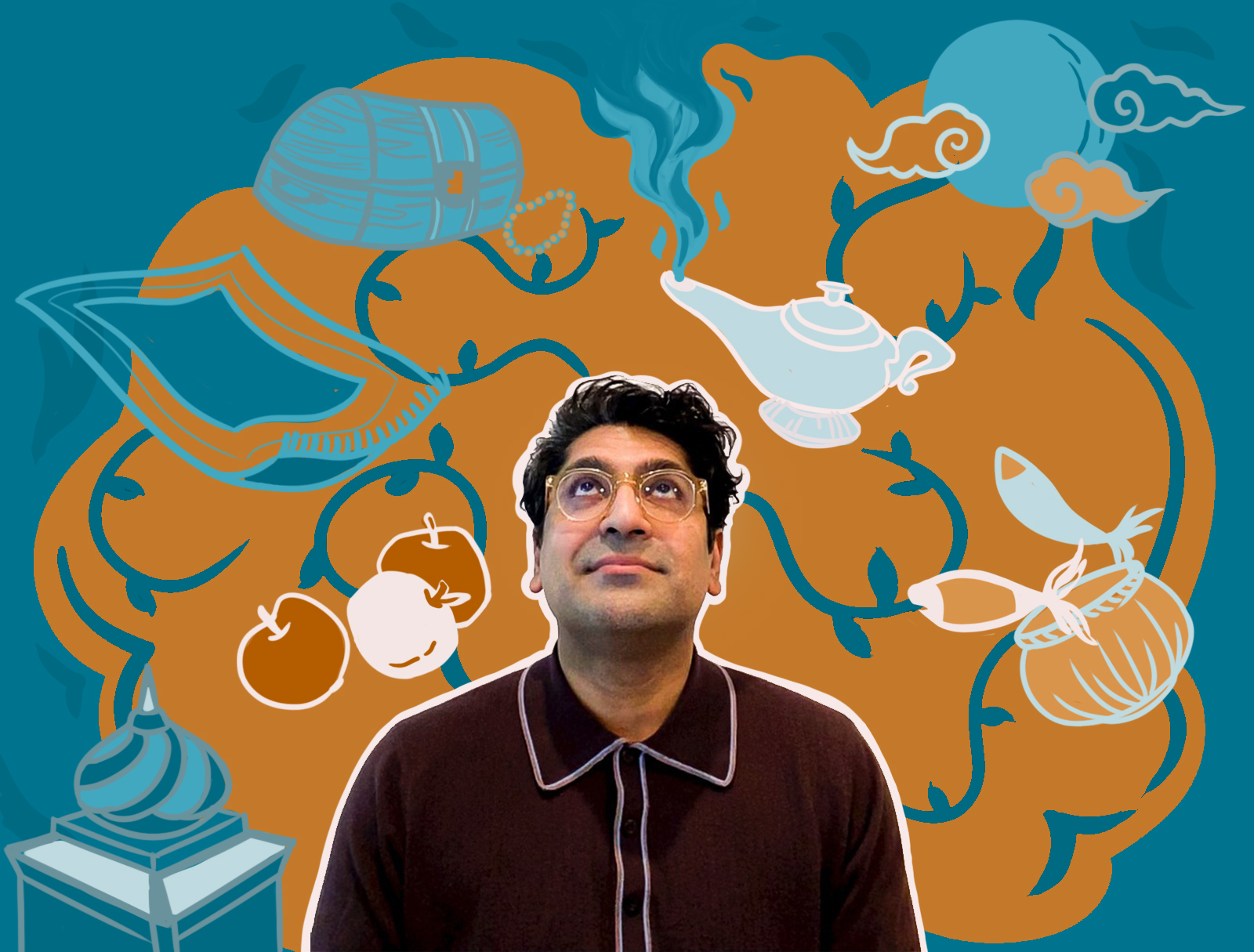Alumnus to create technological retelling of Middle Eastern, South Asian stories

Alumnus Osman Khan plans to use his Guggenheim Fellowship for the fine arts toward a project that retells “One Thousand and One Nights” through technology. The creation will also fuse these tales of the past with immigrant stories of the present. (Photo Illustration by Kanishka Mehra/Assistant Photo editor and Shari Wei/Daily Bruin)
By Tara Oldenburg
May 21, 2020 1:22 p.m.
For Osman Khan, flying carpets are no longer a figment of the imagination.
The alumnus and current director of the University of Michigan’s Master of Fine Arts program received a Guggenheim Fellowship in the field of study of fine arts this year. As of right now, Khan is conceptualizing his newest project by depicting “One Thousand and One Nights” – a collection of Middle Eastern folktales – as well as other Middle Eastern and South Asian mythologies through emerging technologies like artificial intelligence and drones.
“I realized that society was being affected by (new technologies),” Khan said. “I wanted to not just be the maker of this technology but also be critical of it … to reflect back on society a little bit.”
Khan’s projects have included a technological system that ranks viewers of his exhibition based on the number of Google search hits their name incurs, and now he said he’s working to partially recreate tales of the past using AI, drones and contemporary technologies. Media art is an evolving art form just like any other, but Khan said it is nebulous in forms of materiality. Although it is a vast form of artistic expression, Khan said its ability to allow audience participation is a distinctive aspect of media arts.
“With technology, a certain type of interactivity is allowed that I’d like to say a painting or sculpture didn’t allow,” Khan said. “You could say the audience completes the work in their interaction.”
[Related Links: Student paints picture of how science background can strengthen art]
But definitions of the evolving art form are quite complicated, said Casey Reas, a professor of design media arts at UCLA. New media arts is an artistic practice that dates back to the 1920s, Khan said. The artistic expression itself in new media arts is much more amorphous and difficult to define than other art forms because of the ever-changing materiality of the technology, Reas added.
“In the same way that ideas in painting are continuously moving and changing, ideas in media are also changing,” Reas said. “But the medium itself, how software operates or works or what it’s capable of doing also changes. … (It’s) a little more difficult to pin down.”
Khan said he is concretizing his project by incorporating ancient stories through AI oral storytellers that embody Scheherazade – the narrator of “One Thousand and One Nights” – and a carpet that flies with the assistance of drones. As the project is in development, Khan said he is still evolving the specifics of the art, but he hopes digital art can provide him a pre-colonial perspective of Middle Eastern and South Asian history.
Khan’s interests are not exclusively technology-based, as he said he was attracted to older tales from the Middle East and South Asia because they capture the native people’s pre-colonial imaginations. However, Khan said he is aware of the implications of using these technologies to depict these cultures and their histories.
“I’ve been exploring the flying carpet, but it’s now made with drone technology,” Khan said. “But what are drones for a lot of these communities in the Middle East and South Asia? It’s exciting (technology), but it’s also (important to recognize) that same technology’s role … in the contemporary.”
[Related Links: Student artist combines classical art approach with 3D rendering]
His interest in studying humans through a technological lens stems from his studies, Khan said. Victoria Vesna, one of Khan’s previous design media arts professors at UCLA, said Khan recognized that definitions for media arts often describe the relationship between humans, technology and the environment. Khan said he is now applying this ideology to his current project, which relies heavily on the overlap between the past and the present.
“I appreciated his ability to go back and forth between what’s right in front of (the artist) and what could be – with (or without) technology,” Vesna said. “He would just seamlessly go in and out of technological (and nontechnological) ideas.”
By using drones and AI to depict “One Thousand and One Nights,” Khan said he plans to memorialize the modern stories of immigrants with those of the past. However, he said creating time-spanning stories with AI narrators can sometimes pose a challenge as AI must be guided on specific data points, but Khan said he has found similar themes in both ancient mythologies and modern immigrant stories to create a cohesive narrative.
Khan said that many myths are based on occurrences of the everyday and that some immigrant stories can be just as fantastical as the mythologies. Based on practicality and introspection, Khan said he is not placing a time restriction on his work as his plans for the project could change. Regardless, Khan remains committed to sharing both immigrant and pre-colonial stories from the Middle East and South Asia in the finished product.
“I’m trying to extract the fantastical and magical and find a way to reimagine (the stories), but not just have a pure technical illustration of what happened,” Khan said. “(I want to) … understand (the stories) in a contemporary condition as well.”

